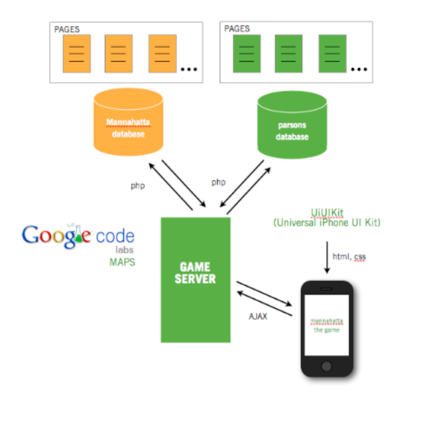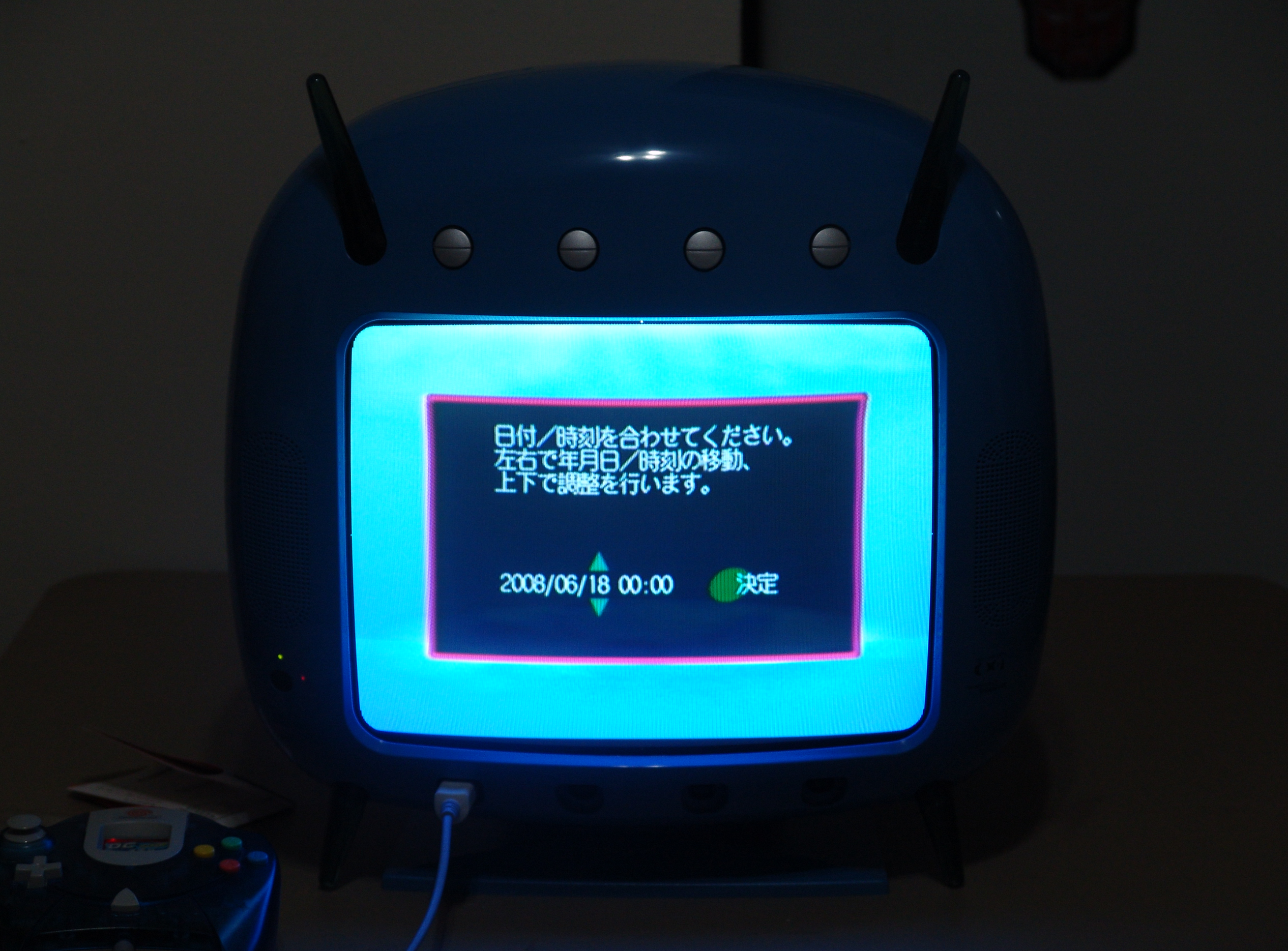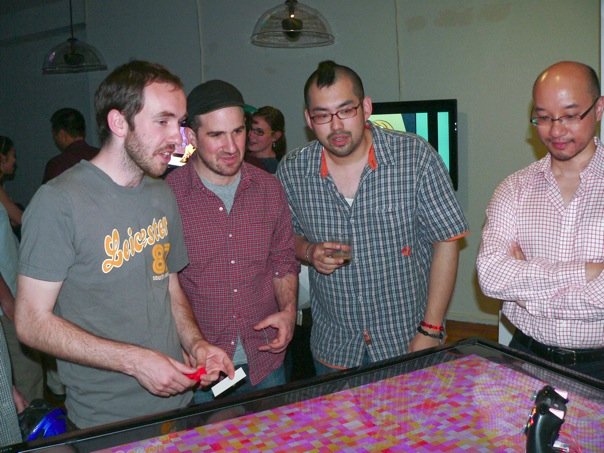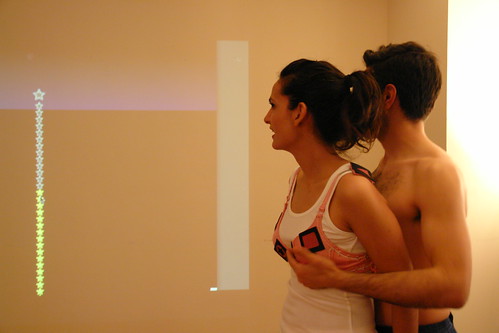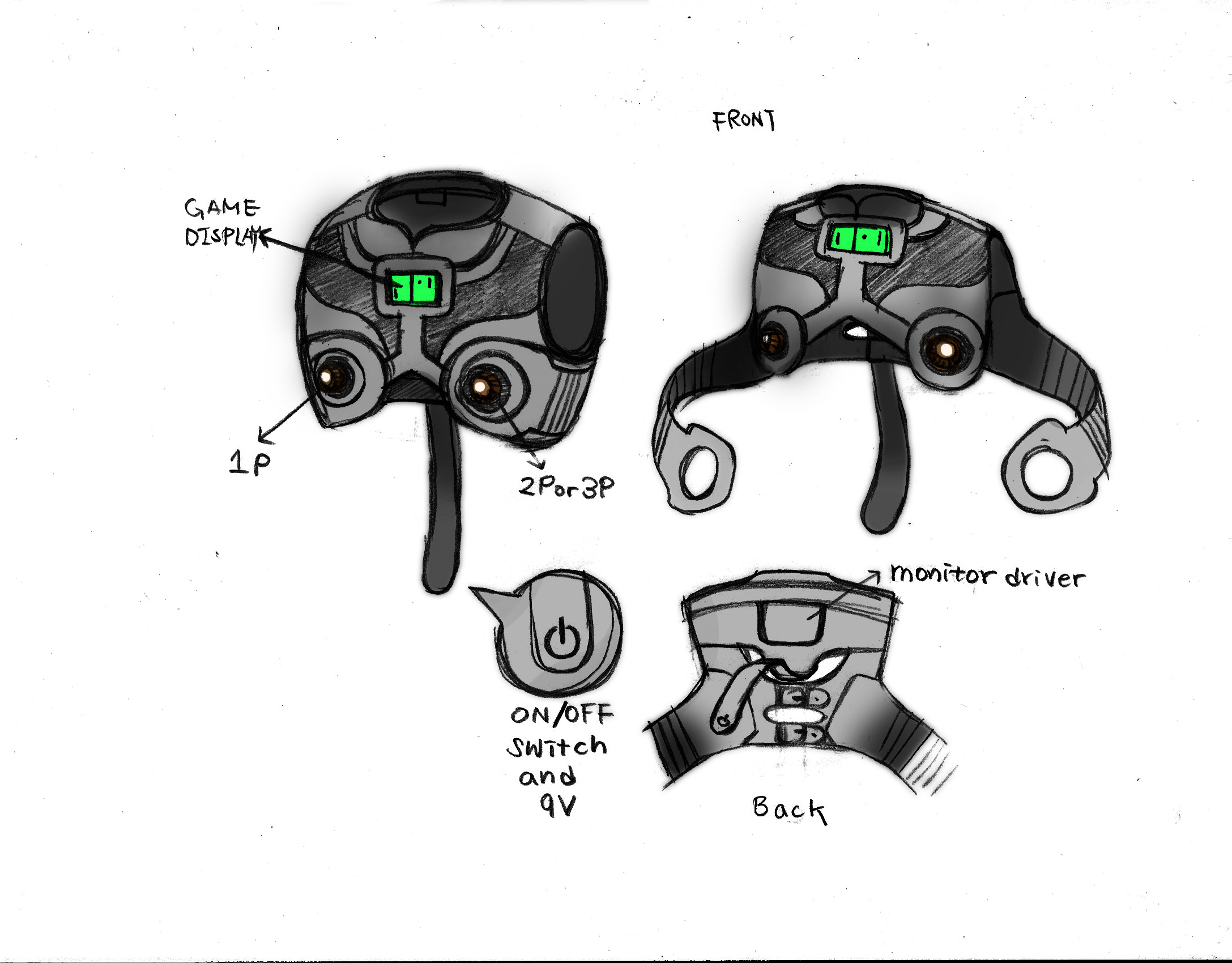
Overview
Mannahatta: The Game is a functional prototype for a location-based smart phone game that maps Manhattan’s historical ecosystem onto its modern day streets. Players move from block to block and gain points when they make connections between ecological elements—including flora, fauna, wind, soil, and water—that existed in the same location when Henry Hudson arrived on the island in 1609. Game play requires growing understanding of ecosystems, managing resources and creating strategic plans for moving about the city. Working individually or as part of a team, a player must connect ecosystem elements across as wide a territory as possible to collect points, earn badges and move to the top of the leader board. The game is targeted to families and youth aged 10-15 years old.
Mannahatta: The Game was built on data from The Mannahatta Project (http://themannahattaproject.org), created by Dr. Eric Sanderson from the Wildlife Conservation Society. At the scale of a present day city block, Sanderson probabilistically determined the flora and fauna that existed on the island 400 years ago and then mapped into onto the city grid. This relationship between historical data and spatial coordinates transforms the city into a living game board, one that fosters situated learning opportunities, encourages teamwork, and develops systems thinking skills. While the game is only a prototype currently, when finished it will exemplify a new kind of 21st century learning product that advances critical competencies through participatory, interest-driven forms of engagement. To learn more about the project, watch this presentation by Dr. Sanderson at the 2009 Global TED Conference or read the article in the September 2009 issue of National Geographic.
Project Origins and Goals
Mannahatta: The Game is a product of the New Youth City Learning Network, which is a group of cultural institutions working together to create interest-driven learning opportunities for youth in New York City with support from the John D. and Catherine T. MacArthur Foundation’s Digital Media and Learning Initiative. Members of New Youth City include the American Museum for Natural History, Bank Street College of Education, City Lore, Boys and Girls Clubs, Cooper-Hewitt National Design Museum, DreamYard, the Joan Ganz Cooney Center, El Museo del Barrio, MOUSE, the Museum for African Art, the New York Public Library, the New York Hall of Science, the Wildlife Conservation Society, and the World Science Festival.
The concept for M:TG emerged during two design charrette sessions (the first held in March 2009 and the second in May 2009) where network organizations identified the idea of ‘neighborhood as learning context’ as a key learning principle and a viable organizing mechanism for collective action. To minimize start up costs and to legitimate the notion of extending existing institutional resources, PETLab (at Parsons The New School for Design) developed a game in the spirit of ‘neighborhood as learning context’ from existing assets (a database and website) owned by the Wildlife Conservation Society, a member organization of the Learning Network. The decision to develop M:TG reflects a commonly held conviction among network members that geographic and informatics competencies are critical for educating tomorrow’s youth. This idea also corresponds to an interest in learning about and acting on local context, especially with mobile devices, expressed by youth participants during the March and May sessions, as well as at third charette in June attended exclusively by teenagers.
The technical prototype for M:TG was developed over the summer of 2009 by PETLab (faculty and student members of the Parsons Design and Technology Department). The team worked for approximately ten weeks to develop the rough prototype, an iPhone application. The first challenge was how to map the rich content of the data-base into an entertaining and substantive game that could be played persistently throughout the city. The team’s iterative design process included technical consultation with Eric Sanderson, consultation with New Youth City Learning Network representatives, critique by game designer, educator and Parsons colleague Katie Salen. Funding for the ten-week pilot project was approximately $90,000. Over the course of the summer various iterations of the game were tested with different youth groups, including middle school students from Williamsburg Collegiate Charter School; 100, 18 year old English Language Learners, and a group of 12 ,15 year olds in a summer design class at Parsons. Findings from each test informed the next stage of development.
Mannahatta project site
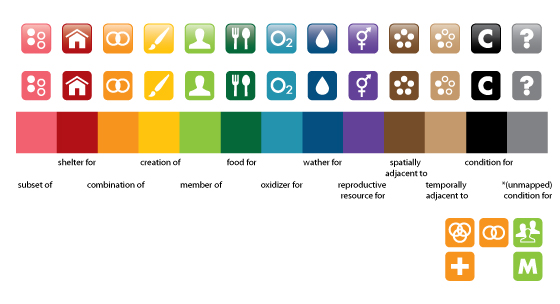
Learning Goals
There were four primary learning goals that drove the design and development of M:TG
1. To introduce and develop a visual and biological understanding of the natural ecosystem of Manhattan in 1609
2. To introduce and develop principles of systems thinking
3. To build comprehension in geographic visualization and navigation
4. To promote proficiency in collaborative teamwork
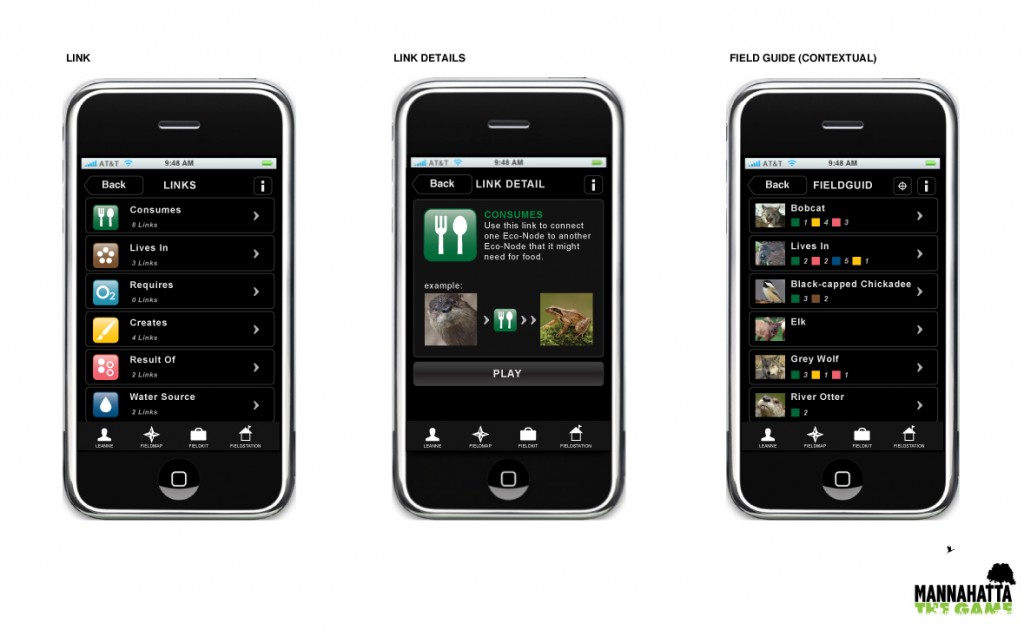
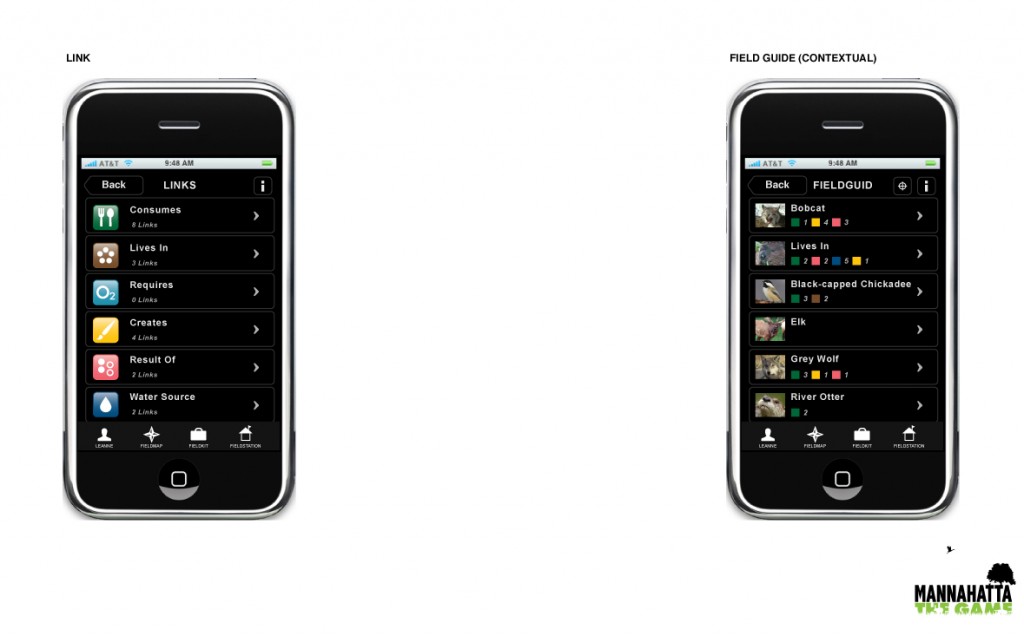
Game Instructions:
Look around Manhattan. What do you see? Concrete, steel, bricks, buildings, streets . . . just about everything is manmade. Now, close your eyes. Imagine yourself here 400 years ago, before European settlement. In those days, the island people, the Lenape, called this place ‘Mannahatta’. Can you envision your surroundings before there was a city under your feet, when the land was covered with lush forests, meadows, streams, ponds, and hundreds of different types of animals?
Your mission is to revive that lost natural world. Use your Habitector to identify Links that you can use to connect Elements. Correct connections will reveal new links for you to collect and use in nearby places. Correct connections also surface new elements and earn you points. The more elements you surface, the more you revive an image of the intricate ecosystem of long-ago Manhattan. The more elements you revive, the more badges you earn and the more likely you are to become a Master of Mannahatta.
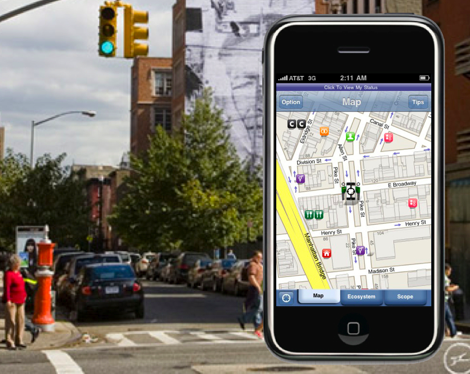
To Start
- Players are introduced to M:TGvia the website (http://mannahattathegame.com) or through New Youth City Learning Network programming. To play the game, a player first downloads the application from the website and installs it on her iPhone or iTouch.
- The iPhone or iTouch detects the player’s location and references that block as Home Block within the game. If a player is not located in Manhattan, the game defaults to a Times Square location.
To Play
- New players are provided with a Field Kit that contains an initial set of Links and Elements. A player enters the game when he makes his first connection between a pair of Elements in his Field Kit by using one of the Links provided. Links represent twelve different ways that a player can form relationships between Elements, such as “is food for” and “is shelter for.”
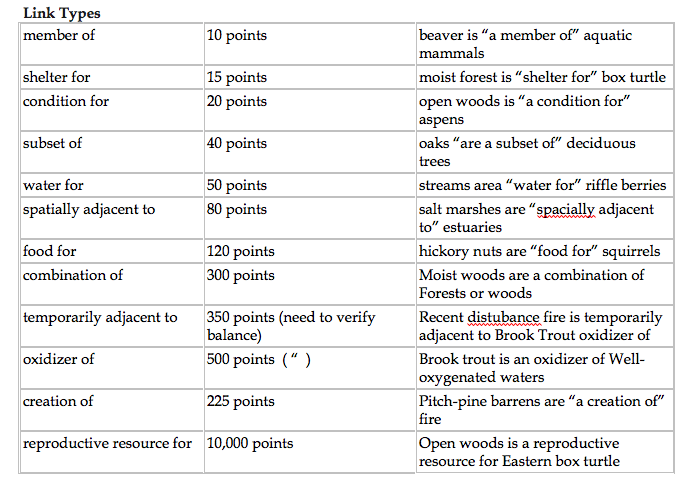
-
- The game progresses as a player uses her Habitector to Surface and Connect additional Elements via Links. The maximum Capacity that a play can have in her Field Kit at any one time is 20 Links. This constraint challenges players to make strategic choices regarding which links to play at any one time (a.k.a. which connections to make) and when to move from one block to the next.
- Making connections using links is the scoring mechanism of the game. Correct connections are scored according to their prevalence or rarity within the historical ecosystem, with rare relationships garnering the most points.
- As they play links and earn points by making correct connections, players also acquire Badges that announce their level of expertise. Expertise is based on the strategic use of Links and and skill at managing which blocks to play. Badges level up from Scout (10 plays of the same Link) to intermediate Ranger (25 plays of the same Link) to Master (50 plays of the same Link). Badges are worth certain points, so, for example, if a player has gained Scout status for five Blocks, Ranger for two, and Master for two, her total points would be 5*20+2*50+2*100 = 400.

- The game also includes a Leader Board, which ranks the top players city-wide based on total points.
- Winning: In the current prototype, there is no end state because there are hundreds of millions of connections that can be made across the island. The current version of the game works on a ‘King of the Hill’ principle, in which whomever is on top of the Leader Board at any given moment is the game champion.
Game Terminology
Badge A mark of Player expertise throughout the game. A player earns multiple badges throughout the game based on the strategic way he plays his Links. Badges also come with bonus points.
Block A current NYC city block or zone that defines a single playable unit of space in the game.
Capacity A player’s current inventory of Links. Maximum Capacity for any player at any one time is 20 Links.
Connect The act of joining two interdependent Elements together via a Link.
Connector A feature of the Habitector. Tap it to use a Link to connect two Elements.
Ecosystem The Web of life as well as its non-biological support system (such as soil and water). Ecosystem elements vary from Block to Block.
Element Any ecological entity (i.e., species, habitat, specific types of wind, soil, water) that existed on the island of Mannahatta in 1609. The main point of the game is to make the correct connections between the Elements in a Block using Links. New Elements are Surfaced through game play.
Field The island of Manhattan serves as the game board or Field. A player must move outdoors through the physical space of the city to play successfully.
Field Guide An information guide that can be accessed at any time during game play. The field guild helps players find information about different aspects of the Ecosystem.
Generate Every time two Elements are connected using the Connector, a player generates another playable Link. The new link appears in her Field Kit by when she moves to an adjacent Block.
Habitector The locative capacities of the iPhone (GPS) and iTouch (cellular triangulation) allow the device to locate a player within the game and about the island.
Leader Board Ranks players overall according to individual achievement in points and accumulation of Badges (Scout, Ranger and Master).
Link The play in the game that joins two Elements together. The more Links played in the game, the more points and badges a player earns. Linking is also the means of Surfacing a larger and larger percentage of the total Ecosystem.
Scope A Habitector feature that allows a player to view the activities of other players. The Scope provides information about the activity on the Block where a player is currently located, an activity overview about game play across the entire island, information about the point scores and badges of other players, and the Leader Board.
Status The Status button allows a player to see her point score and Badge ranking. Status also displays a player’s current Link Capacity, total number of Links played, and total zones visited.
Surface As players successfully connects Elements with a Link using the Connector, more elements are Surfaced.
Technical Information
The Game’s custom software serves as the primary locative controller and resides within the iPhone device or Habitector. The Player installs the software by downloading the application from The Game’s website. (The iPhone was chosen based on the understanding that most New Yorkers ages ten and up, regardless of socioeconomic status, carry cell phones and that in three years time most cell phones will be “smart phones” similar to today’s iPhone.)
The Game is built as a Safari Web App with a home screen navicon. The game server runs on the back end. The game makes use of the data from The Mannahatta Project. The game system built during the Summer of 2009 comprises the game server, the front end built using the iPhone universal UI kit, and the Google Maps API for location-based functionality. The back end provides the front with pages that represent different screens filled in with data as needed. The primary programming language on the front-end is Javascript, which uses the jQuery library for AJAX and display functions. PHP calls handle the communication with the databases. The diagram below shows the basic architecture.
